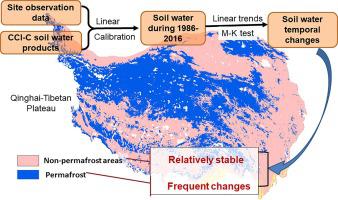Catena ( IF 6.2 ) Pub Date : 2021-08-19 , DOI: 10.1016/j.catena.2021.105668 Guimin Liu 1, 2 , Xiaoli Wu 1 , Lin Zhao 2, 3 , Tonghua Wu 2 , Guojie Hu 2 , Ren Li 2 , Yongping Qiao 2 , Xiaodong Wu 2, 4

|
Permafrost is an important factor affecting soil hydrology in cold regions, while the effects of permafrost on temporal changes in soil water content largely remain unknown. Here, based on the calibrated Climate Change Initiative (CCI) soil moisture products using field observation soil water data at 5 cm depth from 8 representative sites, we examined changing trends of climate conditions and soil water contents during 1986–2016 between the permafrost and permafrost-free sites on the Qinghai-Tibetan Plateau (QTP). We found that all the sites have been experienced continuous warming during this period. Soil water contents showed significant increasing or decreasing trends at three of the four permafrost-free sites, but there were no significant increasing or decreasing changes at all the four permafrost sites. In addition, the Mann-Kendall (M−K) test showed that there were 2 change-points in soil water content for the sites with the active layer thickness was about 2 m, while the sites with active layer thickness larger than 3 m and permafrost-free sites showed 3–5 change-points, indicating that the soil water contents in areas with shallower active layer showed smaller changes. The different changing trends and change-points between permafrost and permafrost-free sites were associated with the existence of permafrost and active layer thickness. Although soil water contents can be affected by many factors, our results suggested that permafrost existence can affect interannual changes in soil water contents, and permafrost degradation including increasing active layer thickness and disappearance of permafrost may decrease ecosystem resilience in the face of climate change.
中文翻译:

1986-2016年青藏高原多年冻土区土壤水分年际变化小于非冻土区
多年冻土是影响寒冷地区土壤水文的重要因素,而多年冻土对土壤含水量随时间变化的影响尚不清楚。在这里,基于校准的气候变化倡议 (CCI) 土壤水分产品,使用来自 8 个代表性地点的 5 cm 深度的实地观测土壤水数据,我们检查了 1986-2016 年多年冻土和多年冻土之间气候条件和土壤含水量的变化趋势- 青藏高原 (QTP) 上的免费站点。我们发现在此期间所有站点都经历了持续变暖。4 个无冻土点中的 3 个点土壤含水量呈显着增加或减少趋势,但 4 个冻土点均无显着增加或减少变化。此外,Mann-Kendall (M-K) 检验表明,活动层厚度约 2 m 的地点土壤含水量有 2 个变化点,而活动层厚度大于 3 m 且无多年冻土的地点的土壤含水量有 2 个变化点。 3-5 个变化点,表明活动层较浅的地区土壤含水量变化较小。多年冻土和无冻土站点之间不同的变化趋势和变化点与多年冻土的存在和活动层厚度有关。虽然土壤含水量受多种因素的影响,但我们的研究结果表明,多年冻土的存在会影响土壤含水量的年际变化,


























 京公网安备 11010802027423号
京公网安备 11010802027423号